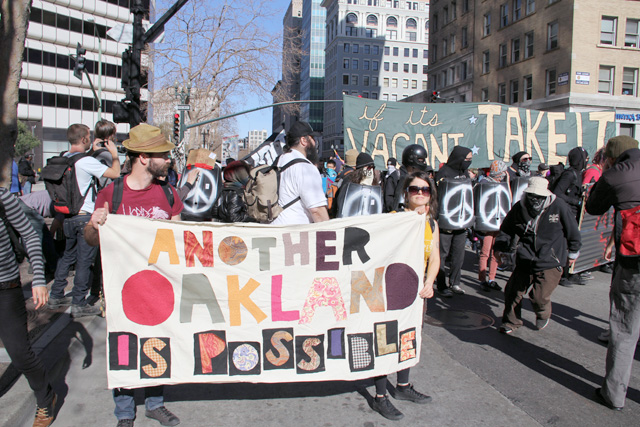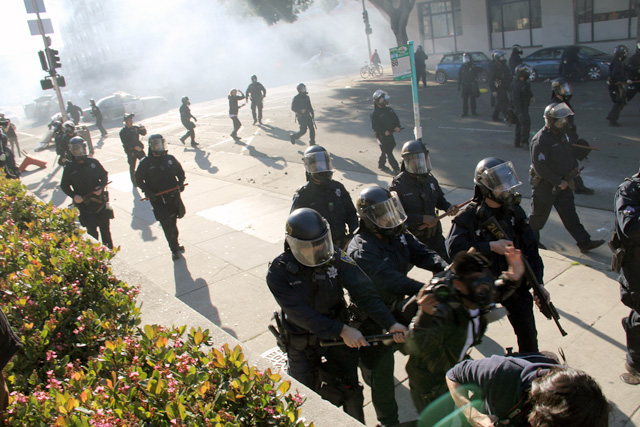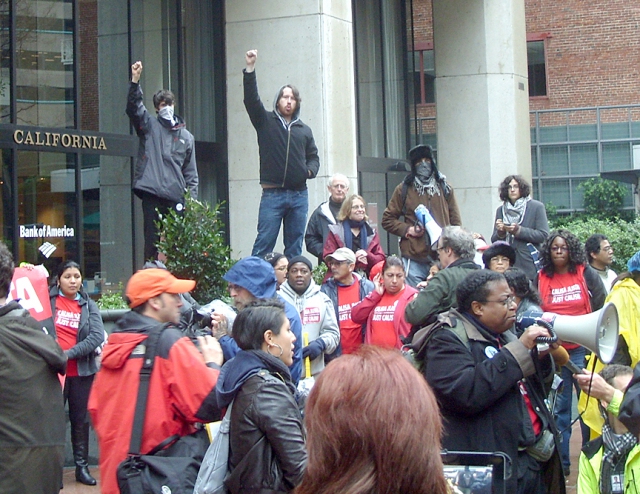 |
| Photo by Dave Id |
As soon as I walked into work on Monday, everyone wanted to talk to me about Saturday’s events in Oakland, since I’m their only real link to the protesters. One woman told me about her father, a militant longshoreman. Another commented that Occupy Oakland seems more organized and less fringy than San Francisco. A guy had been upset by a report that the people committing “violence” – throwing things at the police, etc. – were members of Occupy and not “outside agitators.” I was embarrassed to admit that I was nowhere near most of the excitement.
It’s hard being expected to provide all the answers, when I have mostly questions myself.
The weekend was meant to be a “Move-In Day and Rise-Up Festival.” We were going to take over a huge unused public building, turn it into a multipurpose community space – social center, meeting hall, art workshop, theater, sleeping space upstairs. The big Oakland Commune in the sky, brought down to earth.
Only a handful of people were supposed to know which building we were heading for, but it was an open secret that it was the Kaiser Convention Center near Lake Merritt. My friend observed that since the police were not following the march, they must believe they knew where we were going. A woman heard us and confidently assured us that they did not know. She said, “We might walk by a few places before we get to it.”
I got excited, thinking we might actually get into the planned site. Sadly, she was wrong. A lot of planning went into the weekend but the tactical plan for getting into the building was, apparently, pretty simple: A big march followed by a sound truck and trucks full of furniture and equipment, marching defiantly up to the empty conference center. A row of people with homemade shields painted with peace signs and gas masks or bandanas covering their faces amassed in front, presumably planning to engage the cops while less visible (but still bandana-clad) people (mostly men, natch) cut the fencing around the building and broke the locks. (The Glitter Bloc, young feminists and queers, with a few of us oldsters and some kids in strollers, had been told we would be at the front of the march, but the shield people kept going around us – one of many examples of perhaps trying too hard to please everyone.) There were at least two backup sites selected, but we never got to either of them. Instead we got tear gas, smoke bombs, rubber bullets, people badly injured and as many as 400 arrested.
 |
| more photos by Dave Id |
The police were there in massive numbers, girded in armor and armed to the teeth. They were in no way threatened by a row of people with homemade shields (we’re talking about 15 people, max) or a few guys with bolt cutters. Most of the people on that march had no interest in getting arrested. If the police had made it clear that they were prepared to make a mass arrest, most people would have backed off. They did not need to shoot gas and concussion grenades at kids in strollers, notwithstanding that bringing babies in strollers on that particular action might not have been the smartest idea ever.
Or how is this for a thought: they could have let us have the out-of-the-way, six-years-abandoned building. I actually bet they would let us take it and keep it Saturday, or maybe even for the weekend, let us have our workshops and film showings on Sunday, then when most of us had gone back to work or school on Monday, they would move in and clear out everyone who was left. Yes, there were people on the march who wanted a confrontation with the cops, but the city didn’t have to provide one. They could have let the young men spend their energy moving all that heavy furniture and prying open the windows to air out the moldy conference center.
That’s more or less what the San Francisco police did on January 20, and it worked to their advantage. It’s not because the SFPD is nicer. They brutalize and kill people all the time. They just don’t do it to protesters in front of television cameras – or to the camera people themselves – any more. That’s not because they believe in freedom of speech or assembly; it’s because they paid heavily to settle lawsuits in the eighties and nineties.
 |
| J20 march in SF -- photo by Luke Hauser |
What happened on Saturday could not have been better for Occupy Oakland, which was actually drifting a bit. (The same cannot be said for some of the people who were beaten, arrested, and are now being teargassed in jail.) The two General Assemblies before the move-in failed to make their quorum of 100 people. That didn’t happen this Sunday, despite the fact that 300 potential participants were still in jail. Demonstrations in solidarity with Oakland were held in 13 cities around the country on Sunday night.
There is a lot of testosterone in this movement. That’s not necessarily a bad thing. It’s an annoying thing, especially to feminists, but angry young people – mostly men -- doing battle with the Powers That Be on the streets are iconic in any social movement. People that want Occupy to stop having demonstrations and holding public space and concentrate on community organizing or moving individual families back into foreclosed homes or getting people to move their money are absolutely wrong. Occupy is a mass movement because it is public, photogenic, threatening, filled with the iconography of protest.
At the same time, the Occupy/Liberate/Commune folks need to think about how to use that iconography strategically. I think that the militants in Occupy Oakland assume they have more support from the 99% than they do. Several friends of mine have said, “I don’t object to burning flags, but it’s a bad symbol to give the media.” Others have said that they would not have gone to the march if they knew the F*** the Police bloc was organizing it.
I went to the Occupy Oakland website to donate to the bail fund, because lots of people are being held on bogus felonies – “burglary” for running into the (open) YMCA to get out of the tear gas, “felony vandalism” for having a Sharpie in their pockets when they were arrested (for the record, I have a Sharpie in my purse too – it’s for labeling CDs). Here are a few comments from the donate page:
ae3Some of those comments might be planted by right-wing elements, some might be from people who never supported the movement in the first place, but it would be a mistake to assume that all of them are.
Occupy, you have taken one of the most progressive cities in the country and turned us against you. You have spat in our faces, vandalizing and defecating in my neighborhood at my son’s school after we welcomed you last fall! After Occupy trashed the kids art and smashed the original architects’s model of city hall??? You seriously want money from us??? Go home and p___ in your own backyards!! You seriously want money from us???!!!??? Start washing the grafitti
Tlahtolli
This post is confirmation that Occupy Oakland is being run by kids. You want to privatize the profits and socialize the losses? Seriously?
How about you all grow up and suffer the consequences of your actions. You done goofed up this time.
Simcha
Why should any resident of Oakland or anyone else donate to release people who couldn’t care less about us. Last night we the residents of Oakland were taken hostage by selfish and ego driven zealots who no longer represent us. As an Oakland resident and a member of the 99% I most certainly will not donate to bail out people who care nothing about me or the city of Oakland.
When you have a real movement, behind every young person with a shield are a dozen or more middle-aged people with banners, money, pens, posters and good will. Without that support, the movement cannot succeed. With it, maybe next time we go for a building, we’ll get it.


